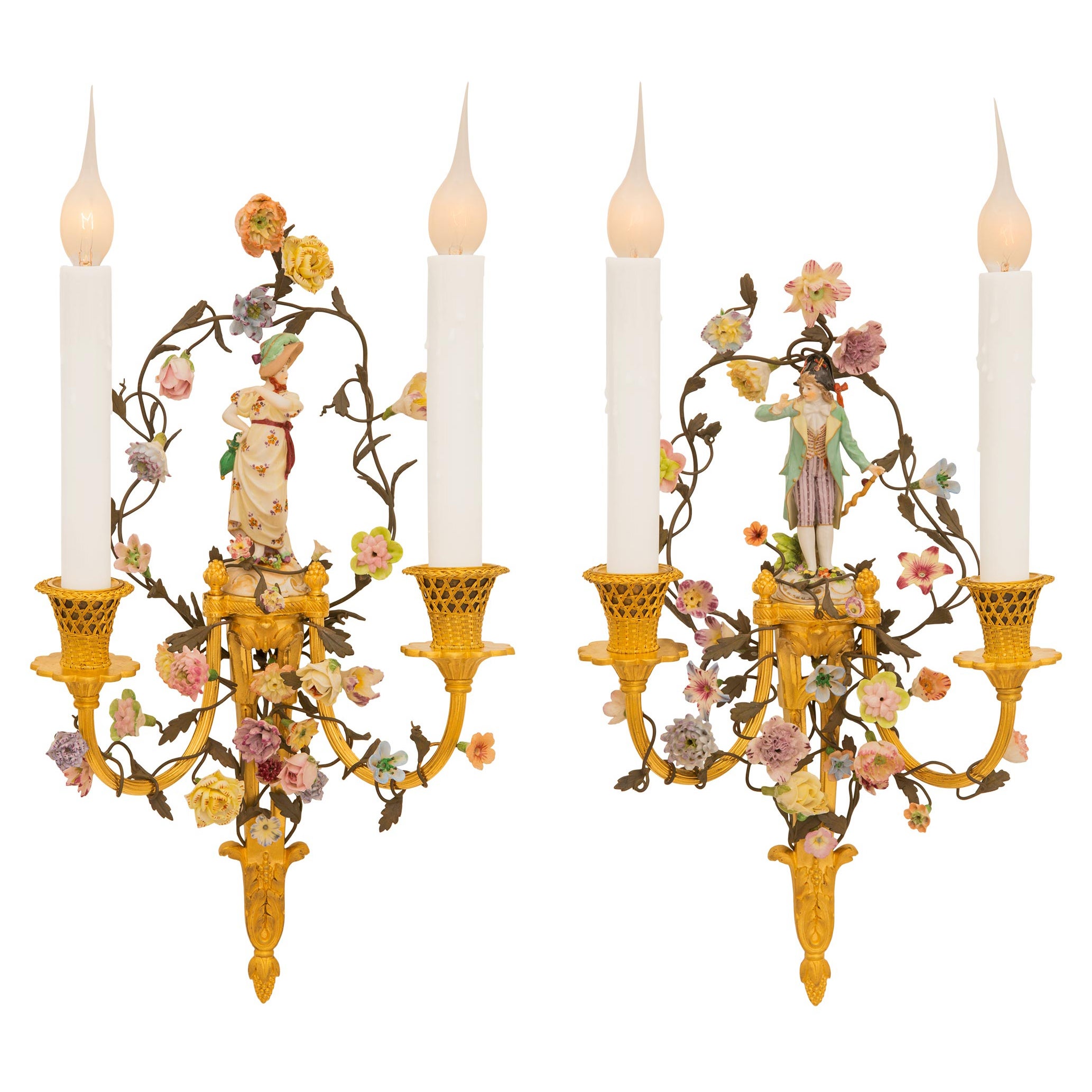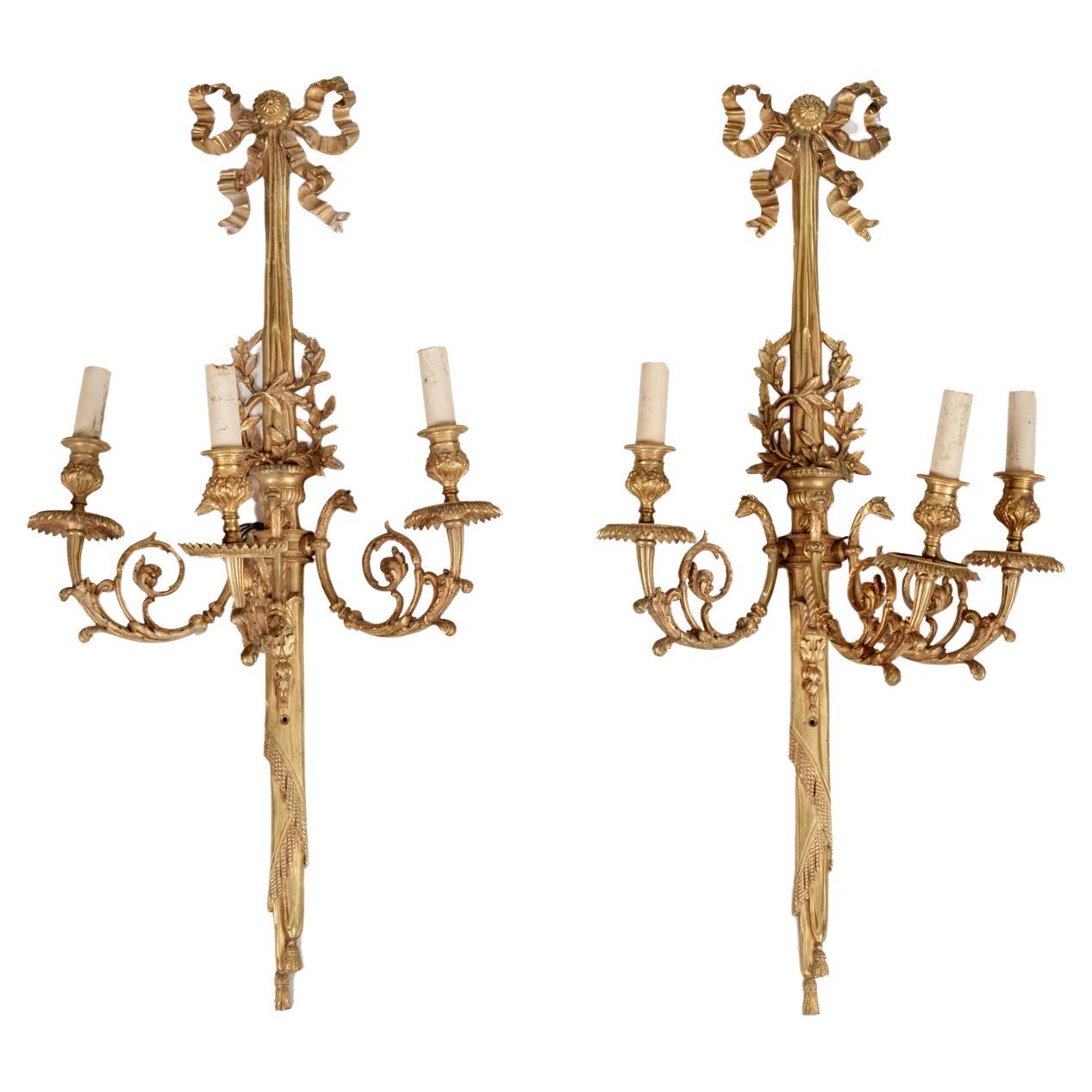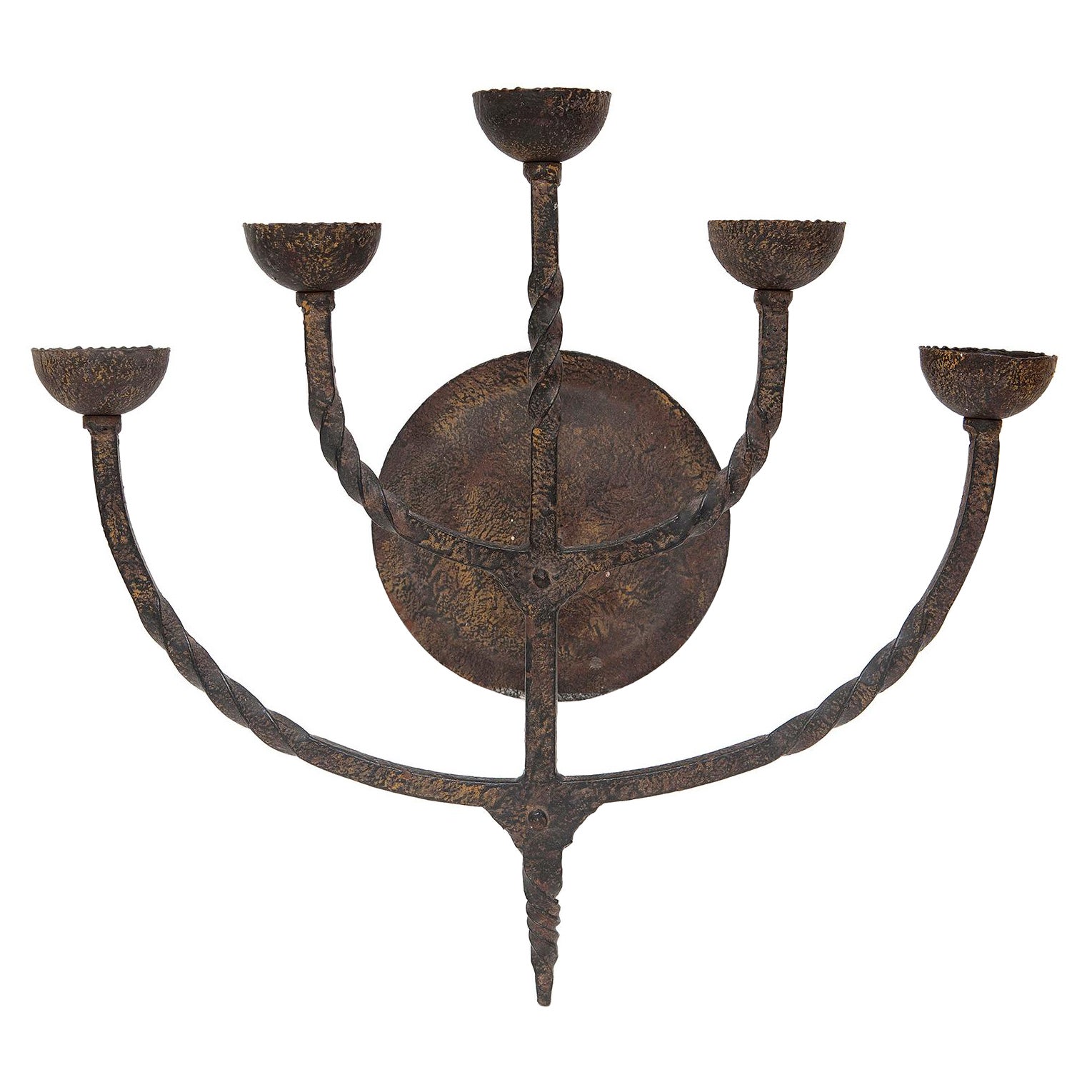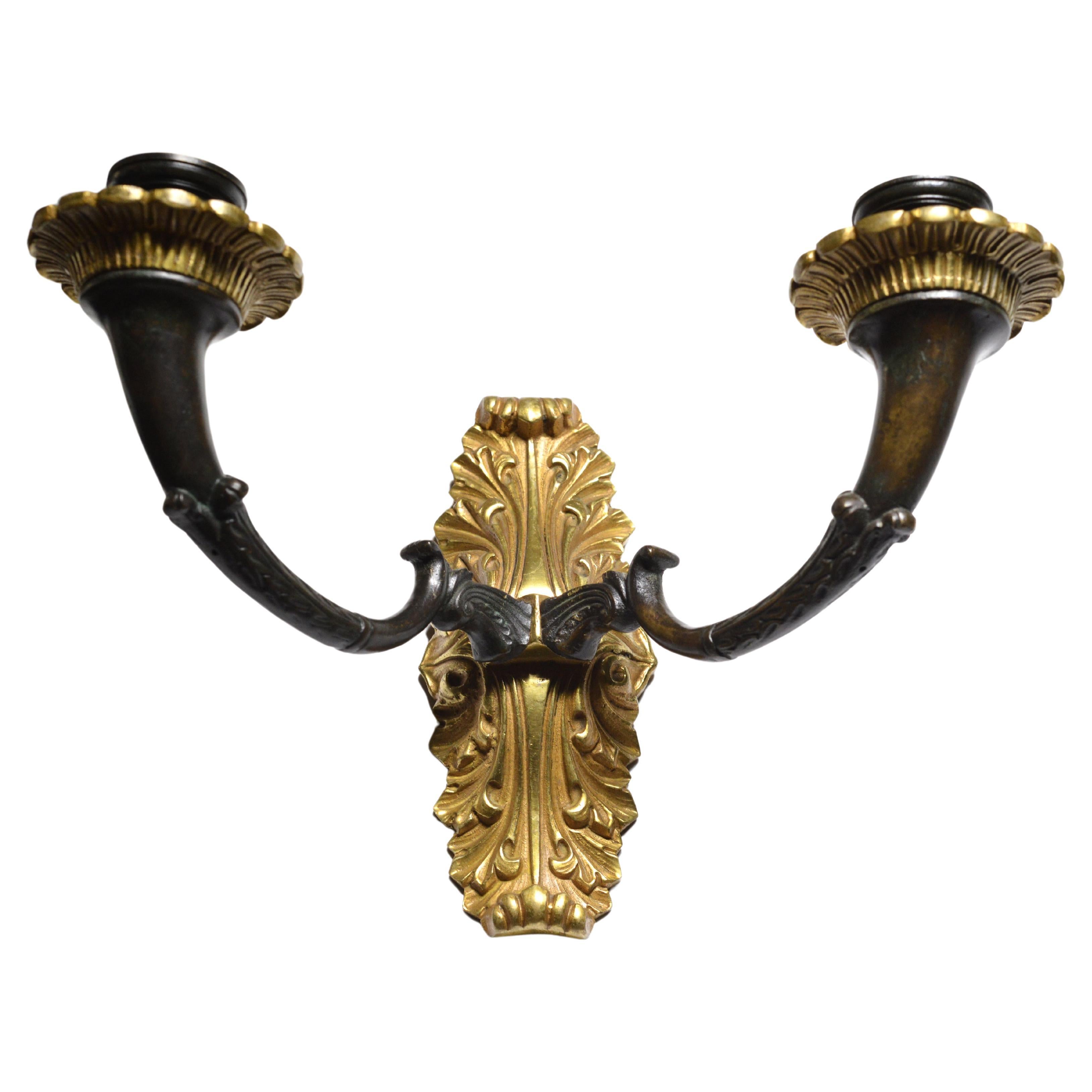Items Similar to Antique Ormolu & Sevres Porcelain Twin Branch Wall Light Sconces 19th C
Want more images or videos?
Request additional images or videos from the seller
1 of 13
Antique Ormolu & Sevres Porcelain Twin Branch Wall Light Sconces 19th C
About the Item
This is a stunning Antique Sevres porcelain and ormolu wall light, Circa 1850 in date.
It features an elegant classical frame topped with a ribbon crest with a satyr mask below and featuring upturned scrolling acanthus twin branch candle sconces.
It features an inset hand painted porcelain panel painted with a portrait of Marie Antoinette. On the reverse it bears marks for Sevres and the printed marks for Chateau Tuileries, and the painted name of Marie Antoinette.
Condition:
In really excellent condition with no chips, cracks or signs of repair, please see photos for confirmation of condition.
Dimensions in cm:
Height 41 x Width 25 x Depth 10
Dimensions in inches:
Height 1 foot, 4 inches x Width 10 inches x Depth 4 inches
Sevres Porcelain
traces its roots in France to early craftsmen who had small manufacturing operations in such places as Lille, Rouen. St. Cloud, and most notably Chantilly. It is from Chantilly that a cadre of workers migrated to the Chateau de Vincennes near Paris to form a larger porcelain manufactory in 1738.
French King Louis XV, perhaps inspired by his rumoured relationship with mistress Madame de Pompadour, took an intense interest in porcelain and moved the operation in 1756 to even larger quarters in the Paris suburb of Sevres. Sevres was also conveniently near the home of Madame de Pompadour and the King's own Palace at Versailles.
From the outset, the king's clear aim was to produce Sevres Porcelain that surpassed the established Saxony works of Meissen and Dresden. Though the French lacked an ample supply of kaolin, a required ingredient for hard-paste porcelain (pate dure), their soft-paste porcelain (pate tendre) was fired at a lower temperature and was thus compatible with a wider variety of colours and glazes that in many cases were also richer and more vivid. Unglazed white Sevres Porcelain "biscuit" figurines were also a great success. However, soft-paste Sevres Porcelain was more easily broken. Therefore, early pieces of Sevres Porcelain that remain intact have become rare indeed.
The Sevres Porcelain manufactory always seemed to be in dire financial straits despite the incredibly fine works it produced. In fact, the king's insistence that only the finest items be created may have contributed to the difficulties. Only a limited number of European nobility could afford the extravagant prices demanded for such works. King Louis XV and eventually his heir, the ill-fated Louis XVI, were obliged to invest heavily in the enterprise. Ultimately, the Sevres Porcelain Factory produced items under the name of "Royal" and thus the well-known Sevres mark was born. King Louis XV even mandated laws that severely restricted other porcelain production in France so as to retain a near monopoly for his Sevres Porcelain. The king even willingly became chief salesman for the finest of his products, hosting an annual New Year's Day showing for French nobility in his private quarters at Versailles. He eagerly circulated among potential buyers, pitching the merits of ownership and policing the occasional light-fingered guest.
Sevres Porcelain may have indeed given the makers of Meissen and Dresden a run for their money by the end of the 18th Century but for the French Revolution. By 1800, the Sevres Porcelain Works were practically out of business due to the economic devastation of the new French Republic.
About the time when Napoleon Bonaparte named himself Emperor of France (1804), a new director was named for the Sevres Porcelain Manufactory. Alexandre Brongniart, highly educated in many fields, resurrected Sevres Porcelain. Soft-paste porcelain was eliminated altogether thanks to the earlier discovery of kaolin near Limoges. For four decades until his death, Brongniart presided over monumental progress for Sevres Porcelain, catering not only to Napoleon himself but at last to include the more financially profitable mid-priced market in the emerging middle class.
Ormolu (from French 'or moulu', signifying ground or pounded gold) is an 18th-century English term for applying finely ground, high-carat gold in a mercury amalgam to an object of bronze.The mercury is driven off in a kiln leaving behind a gold-coloured veneer known as 'gilt bronze'.
The manufacture of true ormolu employs a process known as mercury-gilding or fire-gilding, in which a solution of nitrate of mercury is applied to a piece of copper, brass, or bronze, followed by the application of an amalgam of gold and mercury. The item was then exposed to extreme heat until the mercury burned off and the gold remained, adhered to the metal object.
- Dimensions:Height: 16.15 in (41 cm)Width: 9.85 in (25 cm)Depth: 3.94 in (10 cm)
- Materials and Techniques:
- Period:
- Date of Manufacture:circa 1850
- Condition:
- Seller Location:London, GB
- Reference Number:
About the Seller
5.0
Platinum Seller
These expertly vetted sellers are 1stDibs' most experienced sellers and are rated highest by our customers.
Established in 1983
1stDibs seller since 2012
1,204 sales on 1stDibs
Typical response time: <1 hour
Associations
LAPADA - The Association of Arts & Antiques Dealers
- ShippingRetrieving quote...Ships From: London, United Kingdom
- Return PolicyA return for this item may be initiated within 14 days of delivery.
More From This SellerView All
- Antique Pair Ormolu & Sevres Porcelain Two Branch Wall Lights Sconces 19th CLocated in London, GBThis is a stunning Antique pair of Sevres porcelain and ormolu wall lights, Circa 1870 in date. They feature hand painted oval plaques depicting cherubs in clouds surrounded by flo...Category
Antique 1870s Candlesticks
MaterialsOrmolu
- Antique Pair Sevres Porcelain Mounted Ormolu Candlesticks 19th CenturyLocated in London, GBThis is a delightful antique pair of 19th century French Sevres porcelain mounted ormolu candlesticks, C1870 in date. The square bases and plain column stems with tulip sconces d...Category
Antique 1870s French Porcelain
MaterialsOrmolu
- Antique Pair Sevres Bleu Celeste Porcelain & Ormolu Candelabra 19th CLocated in London, GBA pair of late 19th century French porcelain and ormolu mounted three light candelabra, each with floral and leaf branches above cherubic central column, to floral painted porcelain ...Category
Antique 1860s French Candelabras
MaterialsOrmolu
- Antique Bleu Celeste Sevres Porcelain Ormolu Table Lamp 19th CenturyLocated in London, GBThis is a stunning large antique French Sevres hand-painted porcelain and ormolu mounted vase circa 1870 in date, later converted into a lamp. The ovoid porcelain body is painted...Category
Antique 1870s French Table Lamps
MaterialsOnyx, Ormolu
- Antique French Sevres Porcelain and Ormolu Jewelry Casket, 19th CenturyLocated in London, GBThis is a fabulous antique French Ormolu and Sevres Porcelain jewelry casket, circa 1870 in date. This magnificent casket is rectangular in shape, with the top as well as each sid...Category
Antique 1870s French Porcelain
MaterialsOrmolu
- Antique Bleu Royale Sèvres Porcelain Ormolu Table Lamp, 19th CenturyLocated in London, GBThis is a stunning large antique French Sèvres "Bleu Royale" hand painted porcelain and ormolu-mounted vase circa 1870 in date, later converted into a lamp. The ovoid porcelain bo...Category
Antique 1870s French Porcelain
MaterialsOrmolu
You May Also Like
- French 19th Century Louis XV St. Ormolu, Tole and Sèvres Porcelain SconcesLocated in West Palm Beach, FLA charming and extremely decorative French 19th century Louis XV st. ormolu, tole and Sèvres Porcelain sconces. Each sconce is centered by an ...Category
Antique 19th Century French Louis XV Wall Lights and Sconces
MaterialsMetal, Ormolu
- 19th Century Regency Pair of Triple Branch Wall SconcesLocated in Dublin 8, IE19th Century Regency pair of triple branch gilt metal wall sconces featuring elaborately scrolled candle holder light fittings with acanthus leaf ...Category
Antique 1810s Irish Regency Wall Lights and Sconces
MaterialsMetal
- Wall Sconce Five Arm Branch Wrought Iron 19th Century FrenchLocated in BUNGAY, SUFFOLK19th century, French, wrought iron, 5 arm/branch, baronial, wall sconce, 17½“ high Atmospheric, wall sconce with baronial gravitas The 5 arms have the capacity to create a lot of l...Category
Antique 1850s French Baroque Revival Wall Lights and Sconces
MaterialsWrought Iron
- A Group of Five 19th century 3-light antique European Wall SconcesLocated in Leesburg, VAAnonymous 19th century; Europe Iron and gilt wood Approximate size: 9.5 (h) x 15 (w) x 9.75 (d) inches A collection of five eloquent antique European wall lights in the form of 3-l...Category
Antique 19th Century French Provincial Wall Lights and Sconces
MaterialsIron
- Antique Neoclassical 2 light Gilt Bronze Sconce Wall Candelabra 19th centuryLocated in Sweden, SEStylish and fine detail hand chased bronze and gold-plated (ormolu) sconce in the style of Neoclassicism (also known as Empire style). Made in 19th century in Continental Europe. S...Category
Antique Late 19th Century Neoclassical Wall Lights and Sconces
MaterialsGold Plate, Bronze
- Fine Pair French 19th/20th Century Ormolu Regénce Style Lion Wall Light SconcesLocated in Los Angeles, CAA very fine and impressive pair of French 19th/20th century Regénce style figural gilt-bronze four-light wall sconces appliques, each ormolu lumière centered with a lion pelt mask su...Category
Antique 19th Century French Regency Revival Wall Lights and Sconces
MaterialsOrmolu, Bronze
Recently Viewed
View AllMore Ways To Browse
Antique Photo Wall
Cloud Wall
Antique Hall Light 19th Century
Great Wall Photo
Antique Wall Photo Frames
19th French Wall Light
Antique White Living Room Walls
Antique White Walls Living Room
Antique Wall Case
Sconce Candle Wall Light
Wall Sconce Branches
Branch Wall Sconce
French Antique Wall Light
Antique French Ormolu Piece
Antique Gold Sconce
Twins Photo
Twin Panel
Antique Sconces Large





